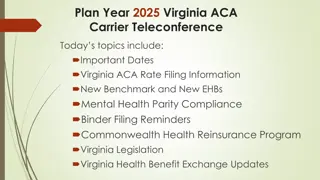Modernizing Data Exchange and Management for CSB Leaders in Virginia
Widespread challenges in data-related processes within the system are prompting the Virginia Department of Behavioral Health & Developmental Services to envision a modernized data exchange platform. This initiative aims to unify platforms, eliminate rework, and enable self-service reporting, ultimately enhancing operational efficiency and decision-making. Despite facing various challenges, DBHDS is committed to becoming a data-driven organization and modernizing taxonomy and data definitions to streamline data management further.
Download Presentation

Please find below an Image/Link to download the presentation.
The content on the website is provided AS IS for your information and personal use only. It may not be sold, licensed, or shared on other websites without obtaining consent from the author.If you encounter any issues during the download, it is possible that the publisher has removed the file from their server.
You are allowed to download the files provided on this website for personal or commercial use, subject to the condition that they are used lawfully. All files are the property of their respective owners.
The content on the website is provided AS IS for your information and personal use only. It may not be sold, licensed, or shared on other websites without obtaining consent from the author.
E N D
Presentation Transcript
Data Exchange Program Information Session for CSB Leaders 4 Mar 2022 Virginia Department of Behavioral Health & Developmental Services 1
The wonders of modern technology It s common knowledge that our system struggles with data- related challenges: Our CCS3/CARS and Taxonomy process causes rework and data mapping for CSBs. Our agency data platforms make warehousing, manipulating, and reporting on data difficult. CSBs are deluged with data calls, multiple platforms, various roll-outs and updates, and more. This list could go on and on Nobody involved is satisfied with where we are. 2
A vision for the future A truly modernized data exchange and management platform Built upon standard and interoperable data definitions Scalable to adapt as the system evolves Capable of resolving inefficiencies, slashing administrative burden, and freeing up valuable resources for mission-oriented work Benefits include: Unification of platforms Elimination of unnecessary data mapping and rework Data warehouse capable of self-service reporting Operational analytics support strategic and tactical decision making at all levels and more 3
Getting there Challenges abound: Workforce shortage COVID-19 pandemic New administration* Battling through current state to keep services online Dealing with the new while tolerating the old On top of that, DBHDS has an up-and-down track record with rolling out similar projects in the past. 4
Commitment The DBHDS team is committed to ensuring this is successful. The most important initiative we have right now. We will be a data-driven organization. We are in the beginning stages and there will be much more to come, including a communications plan to ensure communications are handled well. 5
Taxonomy & Data Definitions A fundamental component of this work is the modernization of our taxonomy and CCS3 system. Tentative project scope: Create a framework for defining data elements utilized by our providers to simplify data acquisition, management, storage, warehousing, and utilization. The framework will leverage industry-standard taxonomic definitions, previous taxonomy work within the system, and other best practices to ensure maximal interoperability. The framework will be scalable to allow for future evolution without having to teardown and rebuild. 6
Latest Updates: We ve enlisted top-flight consultant assistance to help us put arms around this massive undertaking. Excerpt from the Statement of Work: Objective 1: Understand current challenges with the data exchange between CSBs, DBHDS and other key entities (e.g., other state agencies, Federal partners) Work collaboratively with the individuals who have been leading in this area Gather stakeholder input regarding current practices and preferences 7
Objective 1 Continued Interviews: Assume 5-10 across key stakeholders co-developed with DBHDS (e.g., leadership, CSBs, other providers) Identify potential options and impact of each across the full ecosystem Facilitate stakeholder information and agreement sessions to gain consensus on optimal approaches Create an action plan including timelines and stakeholder responsibilities to achieve transition 8
Deliverables 1. Inventory and Impact Analysis of all systems and datasets impacted by taxonomy work. 2. Architecture diagram of recommended future state Data Exchange System to meet collective needs. 3. Action Plan laying out steps toward implementation. 9
Additional Program Updates/Questions Reiterating: We are in the very early stages of this initiative We are committed to a collaborative effort on this We have assembled several leaders from our IT and Data world to provide the very latest updates and answer any questions you may have. 11























